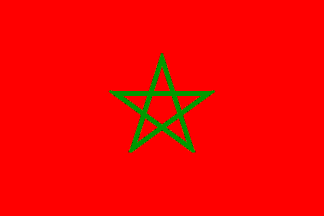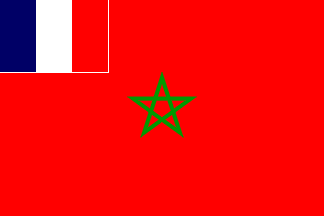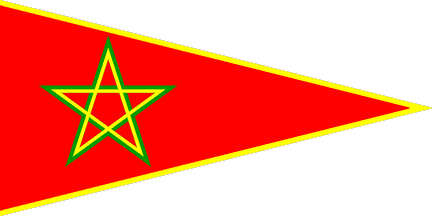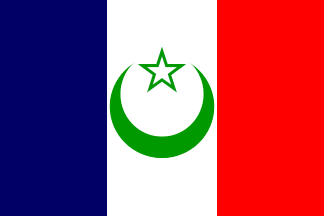
Last modified: 2013-12-16 by antónio martins
Keywords: canton: occupant country | canton: france | civil ensign | star: 5 points (green) | pentagram | seal of solomon | sultan’s standard | star: 5 points (multicolored) | error | crescent: points to top |
Links: FOTW homepage |
search |
disclaimer and copyright |
write us |
mirrors

In the end of the XIXth century, there were a lot of revolts in Morocco
and the European powers decided to solve the “Moroccan problem”.
France occupied Ujda and Casablanca in 1907,
whereas Spain occupied Salwan and other strategic
places in 1909. In spite of German protest, the French
Protectorate over Morocco was established on 30 March 1912. The Sultan
kept a nominal sovereignty. The Spanish zone was
completely autonomous (treaty from 27 November 1912).
Ivan Sache, 15 Jun 2003, based on
[lux01]
Morocco was theoretically an independent state under protectorate, with its own flag and administration, “advised” by a Resident-General.
The most famous Redident-General was Lyautey (1854-1934), who commanded in 1907 the first French intervention in Morocco, created the protectorate in 1912 and was appointed Resident-General from 1912 to 1925. Based on his extensive knowledge of the country and his inhabitants, Lyautey combined military operations of pacification, restoration of traditional Morocco and rejection of direct French administration, and economical development and modernization.
In comparison with the colonial ideology of resource exploitation and direct administration which was widespread at that time, Lyautey can be considered as one of the best French colonial administrators and the relatively peaceful way to independence in Morocco owes him a lot. The comparison with the sad history of neighbouring Algeria, which was part of France, is straightforward.
Ivan Sache, 08 Dec 2000
General Lyautey was appointed High-Commissioner and Resident-General
of Morocco in 1912. He attempted to pacify the country and increase the
Sultan’s authority. Lyautey believed that colonial military
operations were totaly unefficient if not associated with deep political
reforms, which was extremely wise and progressive for the time. At the
end of the First World War, most of Morocco was pacified and economical
development of the country was in process.
Ivan Sache, 08 Dec 2000, based on
[lux01]
Independance of Morocco was accepted by France
on 6 November 1955 and officialized on 2 March 1956, when King Muhammad V
came back from exile. Spain gave back the Rif area
to Morocco on 7 April 1956 and the port of Ifni
in June 1969.
Ivan Sache, 15 Jun 2003, based on
[lux01]

According to Lux-Wurm’s book [lux01],
on 17 November
1915, the civil ensign of Morocco under
French Protecorate was officialized, as a red flag with a green pentagram
placed in the middle. In 1923, the French Tricolore
was added in canton to the civil ensign.
Ivan Sache, 15 Jun 2003
The flag was created by a Dahir (Decree) dated 17 November 1915,
and since I can find no legislation repealing it, and it is indeed shown in
the 1939 Flaggenbuch [neu92], I must
agree that the national flag never bore a tricolore
canton.
Christopher Southworth, 21 Jan 2003
According to Flaggenbuch
[neu92],
the current (and
pre-colonial)
Moroccan flag was the “national” flag.
Ivan Sache, 19 Mar 2000
In Neubecker’s Flaggenbuch
[neu92]
the French Zone National Flag is the same
as same as current
(ratio: 2:3).
Željko Heimer, 12 Jun 2002

The article [ivaXX] confirms
this design.
Mark Sensen, 06 Jun 1996
[See construction sheet contributed by Christopher Southworth, 23 Jan 2002]
In Neubecker’s Flaggenbuch
[neu92]
the French Zone Merchant Flag is a red flag
with green pentagram in the middle and with
white fimbriated French
tricolour in the canton, 1/3 of hoist
high. (ratio: 2:3).
Željko Heimer, 12 Jun 2002
According to Neubecker’s Flaggenbuch
[neu92],
the flag with the French Tricolore in canton was
the civil ensign, not the national flag.
This is not illogical, since the French protectorates of Morocco
and Tunisia were theoretically independent states
which had “required” the generous protection of France (as opposed to
Algeria, which was part of the French Republic
and had not required anything). The Grand Larousse Illustré du
XXème Siécle (1929) also shows a “plain” Moroccan flag
(as well as a “plain” Tunisian flag).
Ivan Sache, 19 Mar 2000
A civil ensign — separate from the national flag for use on land — was created by the Annex to a Decree (Dahir) of 13 March 1919 on the Code Cherifien de commerce maritime, which states that:
Chapter V - On the Arab Ensign
Article 41
The characteristics are as follows: a red ensign with a green Seal of Solomon and a ’tricolore’ shown in the upper corner part of the cloth opposite to the fly.
The ensign was then modified, regulated and defined by a further Decree of 1 September 1923, published on Page 1129 of the Official Gazette dated 18 September 1923, with the relevant part stating that:
Article 41
The Arab merchant ensign shall be flown at sea by ships registered in the French Zone of the Arab Empire, when meeting a warship, when in port (and) when requested (to do so) by the competent authorities.
This ensign is characterized as follows: a red ensign carrying in its centre a green Seal of Solomon with five points. The diameter of the circle containing this Seal of Solomon is equal to one-third the height of the ensign.
It (the flag) has a cut-out in the upper part next to the hoist, (with) a rectangular vertical tricolour (in) blue, white and red. This cut-out covers one third the dimensions of the ensign as detailed above, and is bordered by a white fimbriation of 0m 03 or 0m 05 in width depending on the size of the ensign.
There then follows a list of four sizes of flag ranging from 1.00m × 1.50m to 2.50m × 3.75m. Although the Flaggenbuch [neu92] includes this fimbriation within the one-third quoted above, it is my belief that the wording means that it should be extra to it.
Christopher Southworth, 25 Jun 2004
The tricolore canton was abolished by Dahir No.1-56-059 of 28
April 1956.
Christopher Southworth, 21 Jan 2003
The Civil Ensign of French Morocco was
was not established in 1923, but in 1919.
Christopher Southworth, 25 Jun 2004
Kannik [kan56]
mentions that the French tricolour was included in the
canton of the Moroccan flag from 1923 to 1956.
Ole Andersen, 12 Mar 2000
According to Lux-Wurm’s book [lux01],
in 1923, the French Tricolore was added in canton to
the civil ensign.
Ivan Sache, 15 Jun 2003

1:2 triangular pennant, red with yellow border on outer edges with
green bordered yellow penatgram in the middle. The two coloured pentagram
is made so as if there is green pentagram over which is superimposed
somewhat smaller yellow pentagram (this is important how the colouring
shall be at crossing areas).
Željko Heimer, 12 Jun 2002
According to Flaggenbuch [neu92],
the Sultan’s standard was a triangular red flag with a yellow Moroccan
star fimbriated in yellow.
Ivan Sache, 19 Mar 2000
According to Flaggenbuch [neu92],
it shows a yellow star, without gaps, fimbriated in green, with gaps.
Proportion of the flag is 1:2. Diameter of the star, fimbriation
included, is ca. 2/3rd of the hoist height.
Ivan Sache, 05 Dec 2000
According to Flaggenbuch [neu92],
the star is yellow, continuous (without gaps). Therefore, there is a
“second” green star being the fimbriation, and three non-connected
green sgements to fimbriate the inner pentagone (i.e. the green segments never
cross the yellow lines). Image captioned «Sultanstandarte».
Ivan Sache, 08 Dec 2000
See also: Independent Morocco royal flags
Flaggenbuch [neu92], adds to
the French Zone section: «Flagge des Generalresidenten siehe unter
Frankreich», which means «Flag of the General Resident, see under
France.», refering to this flag.
Željko Heimer, 12 Jun 2002,
and Santiago Dotor, 13 Jun 2002

I’ve just watched Casablanca
(again) and noticed that, right at the beginning of the film above the outside
door to the Préfet de Police’s offices there was a
French tricolor with an Islamic
star and crescent in the central white band (with the open end of the
crescent “pointing” upwards). Being a black-and-white film, I
don’t know the color of the symbol, but it appeared to be the same shade
of gray as the right-hand red band.
Owen Blacker, 27 Oct 2002
(The thing above the door in the movie is not a flag, but a shield.)
The star is not the filled-in kind. I first thought it was a
Moroccan pentagram, but there were no internal
lines — just an outline. The position of the star is such that the
two horizontal arms should be level with the horns of the crescent.
The color of the symbol was a darker shade of gray than either of the bands,
and thus likely a different color, most probably green. The colorized version
of the movie I found at my local library had it in green too, which likely
doesn’t mean anything except that the colorizing technicians may have
concluded it was supposed to be a different color from the side bars too.
Eugene Ipavec, 23 Aug 2005
I have the complete flags laws for Morocco from 1915-1957, and there is no
mention of a tricolore as described. Hollywood of the 1940’s was
not renowned for the accuracy of its history or of its props, and I rather
think that there is little doubt of the flag being an invention to give a
spuriously “authentic” atmosphere.
Christopher Southworth, 27 Jun 2004
Anything below this line was not added by the editor of this page.